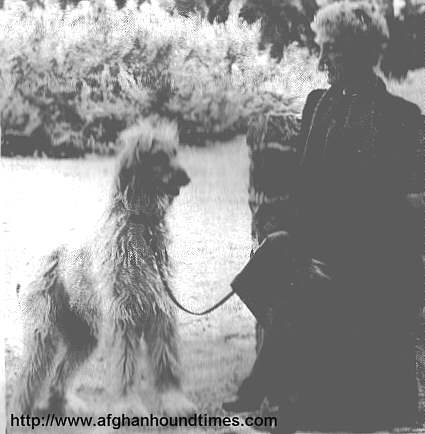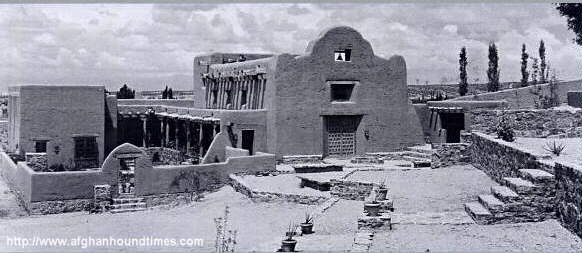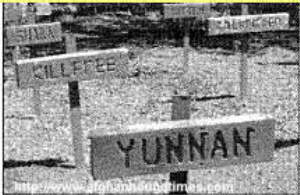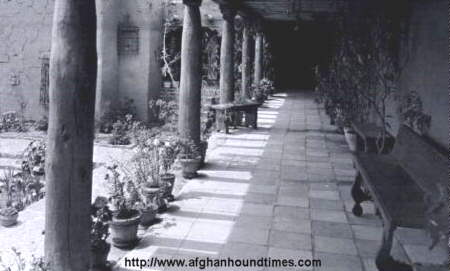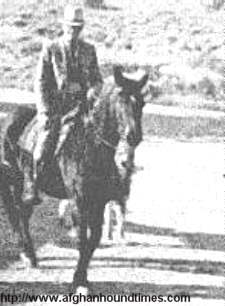(Afghan Hound Database and Breed Information Exchange)
Kandahar Afghan Hounds USA (Author, Steve Tillotson, January 2012) (Page 2)
2. THE MOVE TO SANTA FE The sisters house named "El Delirio" is located in Santa Fe, New Mexico and was built 1924-1929 by William Penhallow Henderson and was furnished with a mixture of contemporary furniture and antiques from New Mexico and Latin America. Amelia and Martha collected Pueblo Indian paintings,- El Delirio, their Santa Fe estate, was a center of the city's intellectual life and remains so to this day.
The dogs lived in very comfortable quarters, raised bed, lined with soft bedding, heated in the cold season. The dogs also got a lot of fresh air as the Kennel Manager Alex Scott would take an entire pack of Wolfhounds out for morning exercise, he on his horse and the pack running alongside. Have to tell this great story from the 1934 AKC Gazette - As far as courage and the response to a call for action is concerned, one case at Rathmullan alone proves that Irish wolfhounds still live up to the greatest traditions of the breed. One day, Alex Scott (Kennel Manager) had the entire lot of hounds out for a run. Suddenly, he came upon a pack of wild dogs, of mixed breeds, that one finds sometimes in that part of the country. These dogs had been harassing the ranchers, killing cattle and running down horses. As soon as he saw these marauders, Scott called in his hounds. All except a young one, Gareth, came to heel immediately. Curious, Gareth went near the pack, and when he turned his back, two jumped on him. For a second it seemed that the whole pack of seven would wipe out the lone wolfhound, but Gareth held his own. Within two minutes of the wildest sort of action, he had flung into the air four wild dogs. The three others put tails between their legs, and fled. Discovery proved that all four dogs that Gareth tossed into the air were dead of broken backs.
3. THE SPIRIT OF SANTA FE In the book "Spirits Of The Border IV: The History and Mystery of New Mexico" by Ken and Sharo Hudnall, they write "Additionally there is no question that the White sisters were somewhat eccentric. The bodies of these two wealthy women are buried under a gazebo on the property, as well as the bodies of some twenty rare Afghan Hounds and Irish Wolfhounds raised by the sisters". "Whatever may be the cause, there is also no question that spirits roam this palatial estate. Some of the staff swears that late in the evenings, they have heard the voices of women talking outside the building. However, when they try to find the source of the conversations, there is never anyone found. On another occasion, an employee working late heard the front doorbell ring. She then heard the front door open and footsteps come down the hallweay to the very room in which she was working. She heard the footsteps enter the room and then retreat back toward the font door, and the the door open and close. During this entire time she saw no one though the steps came to within a few feet of where she sat". 4. EL DELLIORIO SANTA FE HISTORY In terms of the history of Amelia and Martha White's involvement in Afghan Hounds, we are indebted to another breed - Irish Wolfhounds and also the AKC for documenting the establishment and operations of the kennels in Santa Fe. In May 1934 The AKC Gazette featured an article on the kennel writen by Arthur Frederick Jones and is the source for this section. Amelia and Martha White achieved a childhood ambition since seeing their first pair of Irish Wolfhounds exhibited in the USA at Westminster. The sisters decided there and then that if ever they owned a property and grounds sufficiently extensive they would own, breed and exhibit Wolfhounds. Their dream was realised around 1930 when the sisters purchased a 250 acre property, now known as "El Delirio", which has since become The School Of American Research (SAR). The sisters realised how ideal this location would be for a kennel of large hounds. It is located in a large rugged amphitheatre formed by the Sangre De Cristo Mountains, the Hills of El Ortiz, and the Jemez Hills, with the Rio Grande river passing nearby. The property is 7,000 feet above sea level, and an excellent climate - dry at all times, always cool. The terrain is very rugged, and full of deep arroyos or dry river beds. Underfoot, one finds mainly sand and gravel. After looking over the whole place, the owners decided that the best spot for the kennel building would be by the side of one of these arroyos, so that the drainage would be perfect. Also, the arroyo chosen would permit a southeastern exposure to the pen rooms. The kennel building was designed and built along the Spanish pueblo style, to conform with the residence and the nature of the country. E.V. "Jack" Lambert, the ranch superintendent, was the designer and builder. It is a most fitting and artistic structure, decidedly different from any other kennel to be found in the United States. In fact, everything about "El Delirio" is a little different to eyes that are accustomed to the architecture of other sections of the country.The pueblo style, carried through in every instance, dominates the whole 12 acres that has been given over to the residence, the outbuildings, the gardens, the swimming pool, the tennis courts, the stables and corrals, and the kennels. Before taking up the kennel in more detail, perhaps one might form a more faithful picture of life in the Southwest if it were mentioned that the Misses White maintain a stable of nine saddle horses and five pack mules for the use of themselves and their guests. Situated as it is, close to the mountains, one can ride for miles and miles, over the hills, without meeting more than a sheep herder or two, in a day's travel. It is not unusual to see Miss Martha White and her guests riding with the hounds in the early morning, and it is sometimes exciting to see the riders guiding their mounts down the steep bank of a deep, dry arroyo and up again on the other side. And then, if the hounds raise a Jack rabbit, there is plenty of fun and excitement. Miss Martha White is as interested in horses as in dogs, and is an excellent horsewoman. She is fond of jumping and can put a horse over the bars, whether using a saddle or not. She owns a half interest in a ranch near Coolidge, Arizona, where she has a large stable of thoroughbred breeding stock. The gardens near the residence, where one finds many interesting forms of plant life, impossible to raise in any other section of the country, are the particular hobby of Miss Elizabeth White. She is a great lover of flowers. Besides that interest, and her dogs, much of her time is given to Indian welfare work, and she is secretary of the National Association on Indian Affairs. Indian art and handicraft have a strong appeal to her.
(Ed note: Now if we thought the Grandeur kennels in New York were luxurious in the 1990's, putting into context the early era (20's into 30's), the remote and rugged location, absence of technology and later developments in building design and materials, basic and old fashioned grooming equipment, no electric dryers or hydraulic grooming tables etc, the settup at Kandahar is even the more remarkable. Clearly not a cent was spared in providing the hounds with their every need from exercise, nutrition, health, grooming, breeding and rearing etc) Library Of Articles/Main Menu Toolbar |
